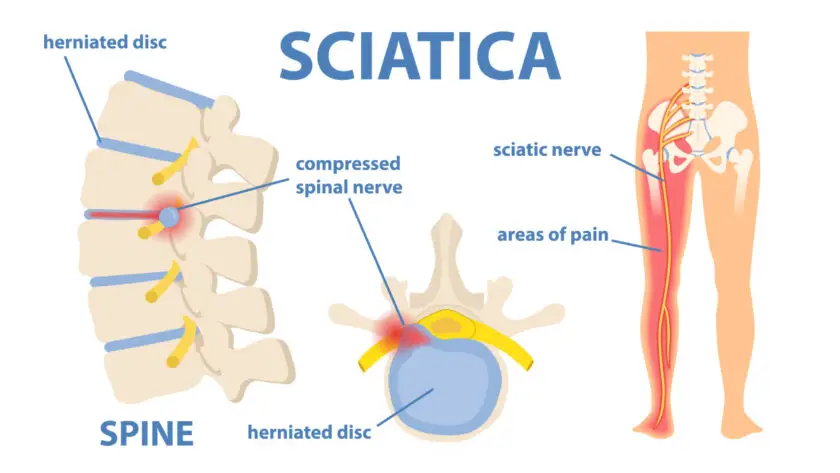In the intricate network of the human body’s nervous system, the sciatic nerve stands as one of the largest and most vital components. Originating from the lower back and extending down the legs, the sciatic nerve plays a pivotal role in connecting the brain to the lower limbs, enabling us to perform everyday movements with ease.
However, when the sciatic nerve becomes compressed or irritated, the result can be excruciating pain that radiates along the nerve pathway, significantly debilitating our quality of life. In the face of such discomfort, individuals are often presented with the prospect of surgery to find relief.
Yet, this course of action may not always be necessary. Fortunately, there are natural approaches that can effectively address sciatic nerve pain, potentially sparing individuals from invasive procedures.
In this article, we delve into the nature of compressed sciatic nerve pain, the risks associated with unnecessary surgery, and explore four natural methods that offer respite and healing. From ancient holistic practices to contemporary insights into pain management, the following sections will unveil a range of alternatives that hold the potential to alleviate sciatic nerve pain, promoting recovery and a return to a pain-free life.
By understanding the underlying causes of this condition and discovering safe, non-invasive strategies, individuals can make informed decisions about their health and well-being. Before resigning themselves to surgery, exploring these natural approaches might just be the key to unlocking relief and restoring vitality.
What Is The Sciatic Nerve
The sciatic nerve is the longest and widest nerve in the human body, originating from the lower spine, specifically the lower lumbar and sacral regions of the spine. It is a major nerve that extends down through the buttocks, travels along the back of each leg, and finally branches out to provide sensation and motor control to various areas of the lower limbs, including the thigh, calf, foot, and toes.
The sciatic nerve is a composite of multiple nerve roots stemming from the spinal cord, primarily the fourth and fifth lumbar (L4 and L5) and the first three sacral (S1, S2, and S3) nerve roots. It plays a crucial role in facilitating communication between the central nervous system (brain and spinal cord) and the peripheral nervous system (nerves throughout the body), enabling movement and transmitting sensory information.
The primary functions of the sciatic nerve include:
- Motor Control: The sciatic nerve controls the muscles in the back of the thigh (hamstrings) and the muscles in the lower leg, which are responsible for various movements, such as extending the hip, flexing the knee, and controlling foot and toe movements.
- Sensory Perception: The sciatic nerve carries sensory signals from the skin of the lower back, buttocks, and the entire lower extremity. This includes sensations of touch, pressure, temperature, and pain from these areas.
- Reflexes: The sciatic nerve is involved in various reflexes, such as the knee-jerk reflex, which provides information about the responsiveness of muscles and nerves in the lower limb.
Given its extensive reach and importance in facilitating movement and sensation in the lower body, any compression, irritation, or damage to the sciatic nerve can result in pain, weakness, numbness, and tingling sensations that radiate down the back of the leg. This condition, known as sciatica, can significantly impact an individual’s daily life.
Understanding the sciatic nerve’s role and the potential issues that can arise with it is essential for addressing and managing conditions like sciatic nerve pain effectively.
What Causes Sciatic Nerve Pain?
Sciatic nerve pain, commonly referred to as sciatica, occurs when there is compression, irritation, or inflammation of the sciatic nerve. This can result from a variety of underlying conditions that affect the nerve or the structures surrounding it. Some common causes of sciatic nerve pain include:
- Herniated Disc: A herniated or slipped disc occurs when the soft inner core of a spinal disc protrudes through its outer layer and presses against nearby nerves, including the sciatic nerve. This compression can lead to pain, numbness, and tingling sensations along the nerve’s pathway.
- Spinal Stenosis: Spinal stenosis is a narrowing of the spinal canal, which can put pressure on the spinal cord and nerves, including the sciatic nerve. This condition is often caused by age-related degeneration of the spine and can result in radiating leg pain.
- Piriformis Syndrome: The piriformis muscle, located in the buttocks, can sometimes become tight or inflamed, causing it to press on the sciatic nerve. This can lead to sciatic nerve pain that originates in the buttocks and travels down the leg.
- Degenerative Disc Disease: With age, the spinal discs between vertebrae can degenerate, leading to decreased disc height and potentially causing compression of the sciatic nerve roots.
- Spondylolisthesis: This condition occurs when one vertebra slips forward over another, causing misalignment of the spine. This misalignment can put pressure on the sciatic nerve roots as they exit the spinal column.
- Muscle Imbalances: Imbalances in the muscles that surround and support the spine can lead to postural issues and nerve compression. Tight muscles can put pressure on the sciatic nerve, leading to pain.
- Injury or Trauma: Direct injury to the lower back, pelvis, or buttocks can result in inflammation or compression of the sciatic nerve.
- Tumors: Rarely, tumors can develop in the spine or pelvis and press on the sciatic nerve, leading to pain and other neurological symptoms.
The hallmark symptom of sciatic nerve pain is a sharp, shooting pain that radiates from the lower back down through the buttocks and the back of the leg, sometimes even reaching the foot and toes. Other symptoms may include numbness, tingling, weakness, and difficulty controlling leg movements.
4 Natural Ways To Stop Sciatic Nerve Pain
When the sciatic nerve sends waves of pain coursing through your lower back, buttocks, and legs, the search for respite becomes paramount. While the prospect of invasive surgery might be looming, there exists a realm of natural alternatives that can offer relief without resorting to the operating table.
1. Applying Warm Compress
Amid the throes of sciatic nerve pain, the simple touch of a warm compress can provide immense relief. By applying a warm compress to the affected area, you engage in a soothing ritual that relaxes both muscles and nerves. The gentle heat encourages blood circulation, aiding in the reduction of inflammation and the mitigation of pain. Conversely, cold compresses can also prove beneficial by numbing the area and decreasing nerve irritation. The choice between warm and cold can be personalized to your preference, both serving as gateways to tranquility.
2. Therapeutic Massage
In the art of self-care, the power of touch is a potent tool against sciatic nerve pain. Employing St. John’s Wort Herbal Extract as your ally, a gentle massage can work wonders in alleviating discomfort.
This essential oil boasts anti-inflammatory properties, aiming to ease the strain that radiates along the sciatic nerve. As your fingers glide over the affected area, they weave a tapestry of relief, coaxing muscles into relaxation and diminishing the grip of pain.
3. Mobility Stretching Exercises
Unlocking the body’s innate capacity for healing, specific stretches tailored to open the hips and fortify the hamstrings can serve as a beacon of hope for those grappling with sciatic nerve pain. Collaborating with a therapist, you can unearth a repertoire of stretches that harmonize with your body’s needs. These targeted stretches not only alleviate immediate discomfort but also pave the way for long-term resilience against sciatic nerve troubles. Strengthened muscles and increased flexibility become your allies in the battle for restoration.
4. The Golden Elixir: Turmeric’s Healing Power
Nature’s pharmacy presents turmeric as a potential remedy to quell the fire of sciatic nerve pain. In a comforting elixir, a teaspoon of turmeric melds with a cup of milk, accompanied by a hint of cinnamon for added warmth. This concoction, simmered to perfection, becomes a balm for inflammation. Turmeric’s renowned anti-inflammatory properties work in harmony with the body, targeting the root of the pain caused by a compressed sciatic nerve. A touch of honey sweetens this remedy, making each sip a step towards liberation from discomfort.
Check Out Micro Ingredients Organic Turmeric Powder & Omica Organics Ceylon Cinnamon (10% Off Code: VFDF7) For Incredible Inflammation Fighting Power!
As sciatic nerve pain threatens to disrupt your life’s rhythm, the realm of natural solutions beckons. In these four methods—warm compresses, therapeutic massage, targeted stretches, and the golden touch of turmeric—you discover a sanctuary of relief. By embracing these holistic approaches, you reclaim command over your body’s narrative, forging a path towards renewed mobility and vitality.
Recommended Reading:
Your Ancestors Used This Popular Oil For Everything: A Remedy For Arthritis, Sciatica, Endometriosis, Back Pain And More
Move Over Lemons, Adding This Fruit To Your Water Every Morning Can Relieve Joint & Muscle Pain, Inflammation & Helps You Lose Weight






